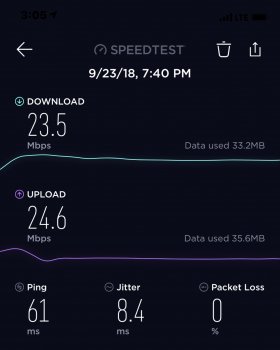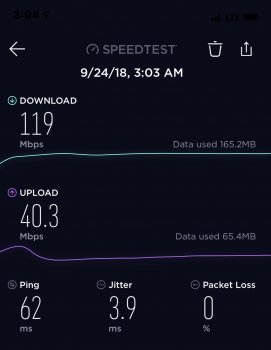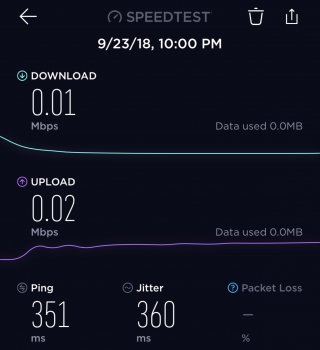Got a tip for us?
Let us know
Become a MacRumors Supporter for $50/year with no ads, ability to filter front page stories, and private forums.
iPhone XS Max Is the mobile reception on the xs Max even worse than iPhone X ?
- Thread starter mydogeatsbeats
- Start date
-
- Tags
- iphon xs max
- Sort by reaction score
You are using an out of date browser. It may not display this or other websites correctly.
You should upgrade or use an alternative browser.
You should upgrade or use an alternative browser.
My wife has an 8 plus and is getting better service than me on my xs plus. This isn’t good.
has anyone done an objective side by side? same network, same low signal area, one device doing what the other cannot? 11 pages and all it seems we have is people saying the new devices aren't as good. but where is the video proof that will obviously become a huge viral hit?
Last edited:
I upgraded from the X to the Xs Max and have noticed this constantly since I started using the Max. In places where I'd normally have fully, fast coverage apps. will tell me that they have no internet connection and just loading simple websites has been slow where they would load quickly on my X even after clearing browser cache, history, etc.. I'm on T-Mobile.
[doublepost=1537767370][/doublepost]
[doublepost=1537767370][/doublepost]
I've received this message from multiple apps. on my Max since I started using it on Friday night. Never got this on my X. I'm on T-Mobile.I just tried logging into my Chase app and it hung up and then I got an error message saying I need to be connected to the internet, despite having 2 bars.
Oh well, when I started this thread I did't even expect that anyone would really respond to this. If it turns out true apple should not get away with this.
I am located in Germany (Cologne, one of the biggest cities in Germany) and as I said: I never had an iPhone since iPhone 4 that had such bad reception there. I still really hope that this is not a hardware issue.
Again: My problem is foremost that I have no or only "Edge" or 3G data reception where I had LTE/4G before. Im on t-mobile (best carrier here). If you go to airplane mode the phone finds LTE but then quickly loses LTE reception where signal isn't the strongest.
I also want to point out: t-mobile uses this data connection for calls! If this signal is weak the calls are too.
I am located in Germany (Cologne, one of the biggest cities in Germany) and as I said: I never had an iPhone since iPhone 4 that had such bad reception there. I still really hope that this is not a hardware issue.
Again: My problem is foremost that I have no or only "Edge" or 3G data reception where I had LTE/4G before. Im on t-mobile (best carrier here). If you go to airplane mode the phone finds LTE but then quickly loses LTE reception where signal isn't the strongest.
I also want to point out: t-mobile uses this data connection for calls! If this signal is weak the calls are too.
Last edited:
Funny you should ask. My XS Max dropped the first call I made from my house. My X wouldn’t have dropped that call. I’m hoping it was just because it didn’t have a chance to optimize the cell network yet if that’s even a thing...
ATT Network here in New Jersey
ATT Network here in New Jersey
Both apparently..Is this issue limited to only the max or the xs as well?
But there are more Max owners here...
For the past two years,
Well a few posts before yours, someone posted actual data speeds
has anyone done an objective side by side? same network, same low signal area, one device doing what the other cannot? 11 pages and all it seems we have is people saying the new devices aren't as good. but where is the video proof that will obviously become a huge viral hit?
Well a few posts before yours, someone posted actual data speeds
Same issue here with my iPhone X EE 4 bars signal.
Work phone iPhone XS Max EE 1-2 bars signal.
Work phone iPhone XS Max EE 1-2 bars signal.
I too am noticing worse performance since picking up my XS Max.
I’m a Vodafone UK user having owned an iPhone X and had pretty consistent performance all around the country as well as abroad.
Since getting my XS Max, I’ve gone from getting 4 bars in my house to 2-3. Just walking around my city, I also notice an increase in pauses listening to music on Spotify, and every coupe of hours my signal simply drops and the phone attempts to reconnect to the network.
I set my iPhone up as new and didn’t restore any settings from my iPhone X. Not looking good...
I’m a Vodafone UK user having owned an iPhone X and had pretty consistent performance all around the country as well as abroad.
Since getting my XS Max, I’ve gone from getting 4 bars in my house to 2-3. Just walking around my city, I also notice an increase in pauses listening to music on Spotify, and every coupe of hours my signal simply drops and the phone attempts to reconnect to the network.
I set my iPhone up as new and didn’t restore any settings from my iPhone X. Not looking good...
I'm starting to think that perhaps when the tower is congested, the phone is not switching to another band and thus the data speeds drop or it's loses connection. I live 3/4 of a mile from the closest tower, that i can see from my house. I attached 2 images. the first showing the speed in the evening, and the second at 3 am. look at the huge difference in speed. My X was never that slow in the evening, but would get that fast after midnight.




Whether in the majority or not, the issue appears to be 'geographically' widespread and unless everyone is imagining, quite real.
If it is in fact a 'carrier settings' or 'ios12' issue, would other iphones continue to perform normally?
If it is in fact a 'carrier settings' or 'ios12' issue, would other iphones continue to perform normally?
So glad I kept my old iPhone X
Purchased a brand new Max 64gb last Friday had two drop calls on the three uk network this phone never gets full signal but my old iphone x always has full signal same location and phone next to each other.
iPhone X 4 BAR SIGNAL ios version 11.2.1 carrier 3UK
iPhone xs 1-2 BAR SIGNAL Max ios version 12 carrier 3UK
Purchased a brand new Max 64gb last Friday had two drop calls on the three uk network this phone never gets full signal but my old iphone x always has full signal same location and phone next to each other.
iPhone X 4 BAR SIGNAL ios version 11.2.1 carrier 3UK
iPhone xs 1-2 BAR SIGNAL Max ios version 12 carrier 3UK
I haven't measured this in any meaningful way but I started using my iPhone Xs Max on Friday, coming from a iPhone X and I use NordVPN with its kill-switch feature enabled. In other words, unless the VPN connection is active it will kill all broadband connectivity on my phone.
This makes it really noticeable to me when my cellular connection drops, as I will notice that the VPN connection drops and re-establishes. Thus far I have noticed that this happens more often on the iPhone Xs Max on my daily commute compared to my iPhone X.
Of course this doesn't have to mean anything. It could be due to congestion at these specific times. It might be due to some additional interference and whatnot. It's impossible to tell but I will keep watching and see if this will be regular thing.
I noticed the same at home. We are doing some renovation so I only have one of our two wireless access points running so WiFi-coverage is somewhat limited. But my iPhone X did not drop WiFi connection when in my bedroom all that often, but my iPhone Xs Max have done so quite a few times so far. Again, this doesn't have to really mean anything but I will keep watching to see if this becomes a regular thing or not.
As cellular/4G/LTE and WiFi+bluetooth are two separate chips, from two different suppliers (Intel for 4G/LTE, and Murata in collaboration with Apple for WiFi+bluetooth) its strange that it would affect both in a noticeable way. Unless the new and improved antenna design is causing some issues? It might also be due to antenna gain optimisation so it can indeed be improved and changed with software and firmware updates.
This makes it really noticeable to me when my cellular connection drops, as I will notice that the VPN connection drops and re-establishes. Thus far I have noticed that this happens more often on the iPhone Xs Max on my daily commute compared to my iPhone X.
Of course this doesn't have to mean anything. It could be due to congestion at these specific times. It might be due to some additional interference and whatnot. It's impossible to tell but I will keep watching and see if this will be regular thing.
I noticed the same at home. We are doing some renovation so I only have one of our two wireless access points running so WiFi-coverage is somewhat limited. But my iPhone X did not drop WiFi connection when in my bedroom all that often, but my iPhone Xs Max have done so quite a few times so far. Again, this doesn't have to really mean anything but I will keep watching to see if this becomes a regular thing or not.
As cellular/4G/LTE and WiFi+bluetooth are two separate chips, from two different suppliers (Intel for 4G/LTE, and Murata in collaboration with Apple for WiFi+bluetooth) its strange that it would affect both in a noticeable way. Unless the new and improved antenna design is causing some issues? It might also be due to antenna gain optimisation so it can indeed be improved and changed with software and firmware updates.
Whether in the majority or not, the issue appears to be 'geographically' widespread and unless everyone is imagining, quite real.
If it is in fact a 'carrier settings' or 'ios12' issue, would other iphones continue to perform normally?
It could be related to the band they use. The Xs and Xs Max can use the faster bands that the X and earlier models are not capable. Maybe these newer bands are not yet ready to be used correctly, and the phone is not switching back to the other bands that the X and older models are using. If that's the case, it could very well be fixed with an iOS update.
I haven't noticed any issues. I still get 2 bars of LTE in my house, just like I did on my 6S. Haven't noticed any difference in coverage/speed.
I have an XS Max and Pixel 2 XL, both on O2. Running speedtest on both at the same time I'm getting around 6Mb/s on the iPhone and 11Mb/s on the Pixel. Test repeated a number of times. Pixel is showing 3 out of 4 bars, iPhone switching between 1 and 2 bars.Same issue here with my iPhone X EE 4 bars signal.
Work phone iPhone XS Max EE 1-2 bars signal.
Anyone having signal problems on 3 UK Network same place same location phone next to each other at work.
iPhone X 64GB Space Grey 3uk 4-5 bars signal never had a call drop out.
iPhone XS Max 64GB Space Grey 3uk 1-2 bars signal calls always drop out.
Something not right here for £1099 phone.
iPhone X 64GB Space Grey 3uk 4-5 bars signal never had a call drop out.
iPhone XS Max 64GB Space Grey 3uk 1-2 bars signal calls always drop out.
Something not right here for £1099 phone.
I tested my new XS (non-Max) on 5GHz WiFi (2.4GHz networks were forgotten and cellular data was disabled) on the edge of its WiFi range on 2 different routers in 2 different homes. The tests were against a new iPhone 8 and my 2-year old iPhone 7. Both the 7 and the 8 absolutely clobbered the XS in speed for these signal conditions (20-40mbps down vs. 3-10 mbps down, and 8-10mbps up vs 0.1-3 mbps up). I was careful to test the phones back to back in the same position being held in the same hand in the same way. I even repeated the tests in the other hand in slightly different positions.
All of the phones perform equally well when near the router in strong signal conditions. To say that the WiFi performance at the edge of the range on the XS is disappointing is an understatement.
The cellular side is harder for me to test properly because coverage is good in my area and B66 has also been deployed (which my iPhone 7 does not support). However just browsing through this thread leads me to caution people on using “bars of signal” as a gauge for signal quality. The relationship between bars and actual signal strength can be different between phones and carriers. You should also check that the old and new phone are using the same band on the same carrier before doing the comparison. Once that has been established use a simple speed test to determine which phone seems to be performing better.
I’m not even sure that we should trust that the rsrp measurements between the different phones are consistent to reality. For repeatability we should probably just use back-to-back speed tests and call quality on identical bands in identical positions.
All of the phones perform equally well when near the router in strong signal conditions. To say that the WiFi performance at the edge of the range on the XS is disappointing is an understatement.
The cellular side is harder for me to test properly because coverage is good in my area and B66 has also been deployed (which my iPhone 7 does not support). However just browsing through this thread leads me to caution people on using “bars of signal” as a gauge for signal quality. The relationship between bars and actual signal strength can be different between phones and carriers. You should also check that the old and new phone are using the same band on the same carrier before doing the comparison. Once that has been established use a simple speed test to determine which phone seems to be performing better.
I’m not even sure that we should trust that the rsrp measurements between the different phones are consistent to reality. For repeatability we should probably just use back-to-back speed tests and call quality on identical bands in identical positions.
Issue happening here too.
Received the phone this morning iPhone XS Max signal bars showing 1 bar.
Old X iPhone showing 4 bars tried the iPhone X sim card into the Max same issue.
Same area and same location test and same sim card test no joy.
Received the phone this morning iPhone XS Max signal bars showing 1 bar.
Old X iPhone showing 4 bars tried the iPhone X sim card into the Max same issue.
Same area and same location test and same sim card test no joy.
Last edited:
Register on MacRumors! This sidebar will go away, and you'll see fewer ads.



